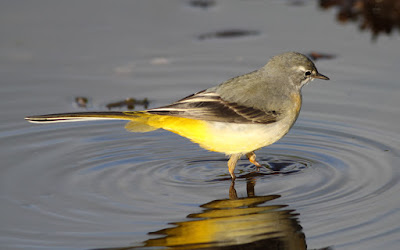The sunny start left me with a dilemma. Paint the walls of the spare bedroom or go birding?
Do It Yourself
After their overnight roost on Pilling Marsh geese were dropping in some numbers when I arrived at Backsands Lane. Several thousand pinkies led the charge with many heading to inland fields across to Bradshaw Lane and Eagland Hill a mile or two away; but the several hundred keen for an early breakfast settled into the immediate pastures. I counted 24 White-fronted Geese more or less together across the same pasture, plus their hanger-on again, the feral/escape Red-breasted Goose.
Pink-footed Geese
White-fronted Goose
Note the picture below. While hordes of geese feed there will always be lookouts assigned to watch for danger. One wrong move from a birder, a slammed car door, or a passer-by with a barking dog and the geese are off into the air to find a safer place.
Pink-footed Geese
Pink-footed Goose, White-fronted Goose, Red-breasted Goose
There’s a really dark pinkie that doesn’t look too well, perhaps suffering from a recent dose of steel shot from the now almost finished shooting season.
Pink-footed Goose
I motored on up to Gulf Lane where although we can’t ring birds at the moment because of the outbreak of avian flu 3 kms away, we can still feed the Linnets. The Linnets were around in their usual numbers with 300+ feeding in our drop-spot of millet and rapeseed. Walking through the set-aside I flushed a Snipe from underfoot, a Grey Wagtail from the ditch and a Skylark from the next field.
As an aside, the latest figure from the avian flu outbreak is that 65,000 birds used for breeding in the shooting industry are to be “humanely slaughtered” in several locations. Suffice to say that the whole episode is a shocking indictment of the business of breeding birds for pleasure shooting.
Rawcliffe Moss held a good variety of birds by way of at least 8 Buzzards circling in the morning air plus a couple of Kestrels on roadside lookout posts. Many thousands of Lapwings and Gulls crowded the still partly flooded fields but unfortunately I’d no inclination to count the masses involved.
I stopped in the spot where earlier in the week were thrushes, buntings and a Stonechat. Lesser numbers today but still 40 Fieldfare, 22 Corn Bunting, 12 Stock Dove, 2 Mistle Thrush, 2 Yellowhammer, a Stonechat and a couple of Skylarks. I noticed today that Skylarks are suddenly becoming more vocal, not necessarily singing but certainly chirruping as they go about their business and a probable prelude to their season starting soon.
Corn Buntings
Skylark
I was pushed for time and with the cloud increasing I headed slowly home.
Now where’s that paint brush?
Linking today to Stewart's World Bird Wednesday, Anni's Birding and Viewing Nature with Eileen.
Linking today to Stewart's World Bird Wednesday, Anni's Birding and Viewing Nature with Eileen.


















































.jpg)












